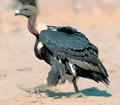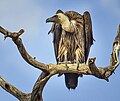| Revision as of 15:23, 24 October 2021 editAwkwafaba (talk | contribs)Autopatrolled, Extended confirmed users, Template editors69,294 edits Taxonbar but this needs a paraphyletic group box i think?← Previous edit | Revision as of 08:19, 25 October 2021 edit undoPi bot (talk | contribs)Bots, IP block exemptions68,305 editsm Removing Commons category (Category:Aegyptini) as it does not existNext edit → | ||
| Line 273: | Line 273: | ||
| * | * | ||
| * | * | ||
| {{Commons category|position=left|Aegyptini}} | |||
| {{Vulture}} | {{Vulture}} | ||
Revision as of 08:19, 25 October 2021
Informal group of birds
| Old World vultures Temporal range: Miocene-Holocene 22.5 Ma PreꞒ Ꞓ O S D C P T J K Pg N ↓ | |
|---|---|

| |
| Lappet-faced vultures (left) and a white-backed vulture | |
| Scientific classification | |
| Kingdom: | Animalia |
| Phylum: | Chordata |
| Class: | Aves |
| Order: | Accipitriformes |
| Family: | Accipitridae |
| Subfamilies included | |
Old World vultures are vultures that are found in the Old World, i.e. the continents of Europe, Asia and Africa, and which belong to the family Accipitridae, which also includes eagles, buzzards, kites, and hawks.
Old World vultures are not closely related to the superficially similar New World vultures and condors, and do not share that group's good sense of smell. The similarities between the two groups of vultures are due to convergent evolution, rather than a close relationship. They were widespread in both the Old World and North America during the Neogene. Old World vultures are probably a polyphyletic group within Accipitridae, with the palm-nut vulture, Egyptian vulture and bearded vulture separate from the others. Most authorities refer to two major clades: Gypaetinae and Gypinae (Aegypius, Gyps, Sarcogyps, Torgos, Trigonoceps and possibly Necrosyrtes). The former seem to be nested with Perninae hawks, while the latter are closely related and possibly even synonymous with Aquilinae. Within Aegypiinae, Torgos, Aegypius, Sarcogyps and Trigonoceps are particularly closely related and possibly within the same genus.
Both Old World and New World vultures are scavenging birds, feeding mostly from carcasses of dead animals. Old World vultures find carcasses exclusively by sight. A particular characteristic of many vultures is a semi-bald head, sometimes without feathers or with just simple down. Historically, it was thought that this was due to feeding habits, as feathers would be glued with decaying flesh and blood. However, more recent studies have shown that it is actually a thermoregulatory adaptation to avoid facial overheating; the presence or absence of complex feathers seems to matter little in feeding habits, as some vultures are quite raptorial.
Species
| Subfamily | Genus | Common and binomial names | Image | Range |
|---|---|---|---|---|
| Gypaetinae | Gypaetus | Bearded vulture Gypaetus barbatus |

|
High mountains in southern Europe, the Caucasus, Africa, the Indian subcontinent and Tibet |
| Gypohierax | Palm-nut vulture Gypohierax angolensis |

|
Forests and savannahs across sub-Saharan Africa | |
| Neophron | Egyptian vulture Neophron percnopterus |

|
Southwestern Europe and North Africa to India | |
| Gypiinae | Aegypius | Cinereous vulture Aegypius monachus |

|
Southwestern and central Europe, Turkey, the central Middle East, northern India and central and eastern Asia |
| †Aegypius jinniushanensis | Formerly China | |||
| †Aegypius prepyrenaicus | Formerly Spain | |||
| Gyps | Griffon vulture Gyps fulvus |

|
Mountains in southern Europe, North Africa and Asia | |
| White-rumped vulture Gyps bengalensis |

|
Northern and central India, Pakistan, Nepal, Bangladesh and Southeast Asia | ||
| Rüppell's vulture Gyps rueppelli |

|
The Sahel region of Central Africa | ||
| Indian vulture Gyps indicus |

|
Central and peninsular India | ||
| Slender-billed vulture Gyps tenuirostris |

|
The Sub-Himalayan regions of India and into Southeast Asia | ||
| Himalayan vulture Gyps himalayensis |

|
The Himalayas and the Tibetan Plateau | ||
| White-backed vulture Gyps africanus |

|
Savannahs of West and East Africa | ||
| Cape vulture Gyps coprotheres |

|
Southern Africa | ||
| Necrosyrtes | Hooded vulture Necrosyrtes monachus |

|
Sub-Saharan Africa | |
| Sarcogyps | Red-headed vulture Sarcogyps calvus |

|
The Indian Subcontinent, with small disjunct populations in Southeast Asia | |
| Torgos | Lappet-faced vulture Torgos tracheliotos |

|
Sub-Saharan Africa, the Sinai and Negev deserts and northwestern Saudi Arabia | |
| Trigonoceps | White-headed vulture Trigonoceps occipitalis |

|
Sub-Saharan Africa | |
| †Neogyps |
† = extinct
Population declines, threats, and implications
Population declines
More than half of the Old World vulture species are listed as vulnerable, endangered, or critically endangered by the IUCN Red List. Population declines are caused by a variety of threats that vary by species and region, with most notable declines in Asia due to diclofenac use. As vultures play an important role in ecosystems, their population decline can have cultural, public health, and economic implications for communities. Within Africa, a combination of poisonings and vulture trade (including use as bushmeat and traditional medicine) account for roughly 90% of the population declines.
Threats
Diclofenac
Diclofenac poisoning has caused the vulture population in India and Pakistan to decline by up to 99%, and two or three species of vulture in South Asia are nearing extinction. This has been caused by the practice of medicating working farm animals with diclofenac, which is a non-steroidal anti-inflammatory drug (NSAID) with anti-inflammatory and pain-killing actions. Diclofenac administration keeps animals that are ill or in pain working on the land for longer, but, if the ill animals die, their carcasses contain diclofenac. Farmers leave the dead animals out in the open, relying on vultures to tidy up. Diclofenac present in carcass flesh is eaten by vultures, which are sensitive to diclofenac, and they suffer kidney failure, visceral gout, and death as a result of diclofenac poisoning.
Meloxicam (another NSAID) has been found to be harmless to vultures and should prove an acceptable alternative to diclofenac. The Government of India banned diclofenac, but over a year later, in 2007, it continued to be sold and remains a problem in other parts of the world.
Other poisonings
Poisoning accounts for a majority of vulture deaths in Africa. Ivory poachers poison carcasses with the intent of killing vultures, since vultures circling over a carcass alert authorities to a kill. Vultures are also unintentionally poisoned when they consume carcasses of predators that have been poisoned by livestock farmers.
Traditional medicine / belief and use
Vultures in Africa are killed for use in traditional medicine as part of the African vulture trade. Vulture heads are believed to provide clairvoyance.
Bushmeat consumption
Another part of the African vulture trade is use for bushmeat consumption.
Electrical infrastructure
Collisions with electrical infrastructure account for roughly 9% of vulture deaths in Africa. Some organizations in South Africa are working with power companies to mitigate this threat.
Implications
As vultures play an important role in ecosystems, their population decline can have cultural, public health, and economic implications for communities.
The decline in vultures has led to hygiene problems in India as carcasses of dead animals now tend to rot, or be eaten by rats or feral dogs, rather than be consumed by vultures. Rabies among these other scavengers is a major health threat. India has one of the world's highest incidences of rabies.
For communities such as the Parsi, who practice sky burials in which human corpses are put on the top of a Tower of Silence, vulture population declines can have serious cultural implications.
Conservation efforts
A project named "Vulture Restaurant" is underway in Nepal in an effort to conserve the dwindling number of vultures. The "restaurant" is an open grassy area where naturally dying, sick, and old cows are fed to the vultures.
Organizations across Africa are working to reduce threats to vulture species with efforts to change and create policies to protect species both at the national and international scale.
References
- Lerner & Mindell 2005.
- (Griffiths et al. 2007, Lerner and Mindell 2005)
- ^ Mundy, P. et al. 1992. The Vultures of Africa, Academic Press.
- ^ Wilber, S. & Jackson, J. 1983. Vulture Biology and Management, University of California
- (Ward et al. 2008)
- "AnimalDiversityWeb: Aegypius: Classification". AnimalDiversity.ummz.umich.edu. Retrieved 2011-05-28.
- ^ Ogada, Darcy L.; Keesing, Felicia; Virani, Munir Z. (2012-02-01). "Dropping dead: causes and consequences of vulture population declines worldwide". Annals of the New York Academy of Sciences. 1249 (#1): 57–71. Bibcode:2012NYASA1249...57O. doi:10.1111/j.1749-6632.2011.06293.x. ISSN 1749-6632. PMID 22175274. S2CID 23734331.
- ^ "Painkillers turned bird killers". New Scientist. No. 2577. 2006-11-14. p. 7.
- ^ Elizabeth Royte (2015-12-10). "Vultures Are Revolting. Here's Why We Need to Save Them". National Geographic Magazine. Retrieved 2016-02-29.
- ^ Madeline Bodin (2014-08-11). "Africa's Vultures Threatened By An Assault on All Fronts". Yale Environment 360. Retrieved 2016-02-29.
- ^ Dooren, Thom van (2010). "Vultures and Their People in India: Equity and Entanglement in a Time of Extinctions". Manoa. 22 (#2): 130–146. ISSN 1527-943X.
- Di Quinzio & McCarthy 2008.
- Haviland, Charles (2008-07-31). "Nepal's 'restaurant' for vultures". BBC News. Retrieved 2011-05-28.
- A vulture restaurant in South Africa Archived December 27, 2008, at the Wayback Machine
- "Multi-species Action Plan to Conserve African-Eurasian Vultures (Vulture MsAP) | CMS". www.cms.int. Retrieved 2018-04-18.
- Di Quinzio, M.; McCarthy, A. (2008-02-26). "Rabies risk among travellers". CMAJ. 178 (5): 567. doi:10.1503/cmaj.071443. PMC 2244672. PMID 18299544.
- Ferguson-Lees, James; Christie, David A. (2001). Raptors of the World. Illustrated by Kim Franklin, David Mead, and Philip Burton. Houghton Mifflin. ISBN 978-0-618-12762-7. Retrieved 2011-05-26.
- Grimmett, Richard; Inskipp, Carol; Inskipp, Tim (1999). Birds of India, Pakistan, Nepal, Bangladesh, Bhutan, Sri Lanka, and the Maldives. Illustrated by Clive Byers et al. Princeton University Press. ISBN 978-0-691-04910-6. OCLC 43578307.
- Lerner, Heather R. L.; Mindell, David P. (November 2005). "Phylogeny of eagles, Old World vultures, and other Accipitridae based on nuclear and mitochondrial DNA" (PDF). Molecular Phylogenetics and Evolution. 37 (2): 327–346. doi:10.1016/j.ympev.2005.04.010. ISSN 1055-7903. PMID 15925523. Retrieved 31 May 2011.
- Sinclair, Ian; Hockey, Phil; Tarboton, Warwick (2002). SASOL Birds of Southern Africa. Illustrated by Peter Hayman & Norman Arlott (3rd ed.). Cape Town: Struik. ISBN 978-1-86872-721-6.
- "Bird groups hopeful on vultures". BBC News. London. 2006-02-06. Retrieved 2011-05-29.
- Gentleman, Amelia (2006-03-28). "India's Vultures Fall Prey to a Drug in the Cattle They Feed On". The New York Times. ISSN 0362-4331. Retrieved 2011-05-29.
- Nair, Preetu (2009-05-09). "Rare breed of vulture spotted in Goa after eight years". The Times of India. Archived from the original on 2012-06-12. Retrieved 2011-05-29.
External links
- Internet Bird Collection.com: Vulture videos
- Indian birds.com: videos, photographs and resources
- Publico.pt: A griffon vulture nest
| Taxon identifiers | |
|---|---|
| Aegypiinae | |